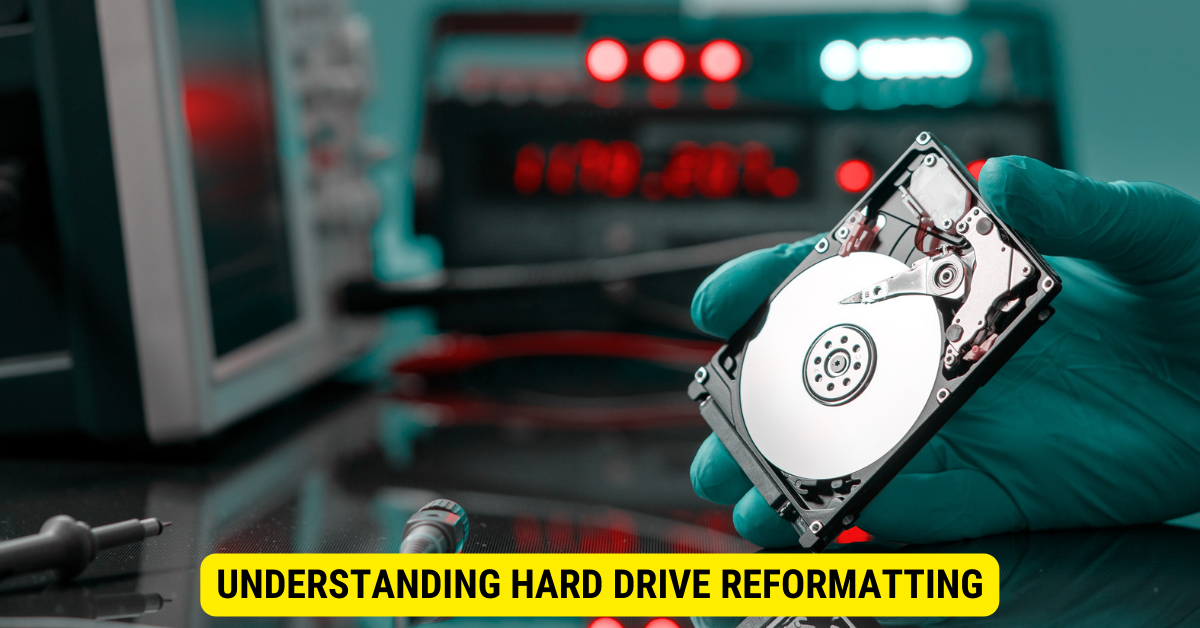Reformatting a hard drive does not securely delete the data contained within it. Instead, the data remains intact and can potentially be recovered. For secure data deletion, consider using methods such as data wiping software, degaussing, or physical destruction, depending on your specific situation and needs.
In today’s digital age, the security and privacy of our data have become paramount concerns. When it comes to disposing of or repurposing an old hard drive, the question arises: Will reformatting securely delete data from a hard drive? This article aims to shed light on this topic and explore the effectiveness of reformatting as a method for data deletion.
Understanding Hard Drive Reformatting

Before delving into the topic at hand, it is essential to understand what reformatting entails. Reformatting refers to the process of erasing all data and resetting the file system on a hard drive. It involves creating a new file system structure by dividing the drive into sectors and allocating space for files.
During the reformatting process, the existing data on the hard drive is overwritten with new information. This process essentially removes all traces of the old data by replacing it with new file system metadata.
What is Reformatting?

Reformatting is a procedure commonly used to prepare a hard drive for a new operating system installation or resolve file system errors. However, it is important to note that reformatting primarily focuses on creating a clean file system rather than securely deleting data.
When a hard drive is reformatted, it wipes away all the data stored on it, including documents, photos, videos, and any other files. It is crucial to back up important files before proceeding with the reformatting process to avoid losing valuable data.
Reformatting can also be used as a troubleshooting method to address various issues with a hard drive. If a hard drive becomes corrupted or develops errors, reformatting can help resolve these problems and restore the drive’s functionality.
The Process of Reformatting a Hard Drive
The process of reformatting a hard drive involves several steps. First, the user initiates the reformatting process through the computer’s operating system or specialized software. It is essential to ensure that all necessary data has been backed up before proceeding, as reformatting will erase everything on the drive.
Next, the software marks all sectors on the drive as available and erases the existing file system metadata. This step effectively removes the old file structure and prepares the drive for the creation of a new file system.
Once the file system metadata is erased, the software creates a new file system structure and allocates space for files. The user may have the option to choose between different file system formats, such as NTFS or FAT32. Each file system format has its own advantages and limitations, so it is important to consider the specific requirements and compatibility of the intended use.
After selecting the desired file system format, the reformatting process continues by formatting the drive with the chosen format. This step involves dividing the drive into sectors and assigning file system metadata to each sector, enabling the operating system to organize and access files.
Finally, the reformatting process is complete, and the hard drive is ready for use with a new file system. It is important to note that after reformatting, all previous data will be permanently deleted and cannot be recovered without specialized data recovery tools.
Once the hard drive is reformatted, it can be used for various purposes, such as reinstalling an operating system, creating a new partition, or simply starting with a clean slate. However, it is crucial to be cautious during the reformatting process to avoid accidental data loss and ensure that all necessary precautions are taken to safeguard important files.
The Impact of Reformatting on Data
While reformatting creates the illusion of a clean slate, it is important to understand the impact it has on the underlying data. Reformatting alone does not provide foolproof data security. The effectiveness of data deletion through reformatting depends on several factors.
When a hard drive is reformatted, the process primarily focuses on erasing the file system metadata rather than the actual data stored on the drive. The data itself remains intact unless overwritten by new information. In most cases, reformatting simply marks the data sectors as available for reuse without securely erasing the previously stored information.
This means that even after reformatting a hard drive, the original data may still be recoverable. Specialized data recovery software or forensic techniques can potentially recover the overwritten or marked as available data. This is especially true if the reformatting process does not involve the complete overwriting of the entire drive.
However, it is important to note that the likelihood of data recovery after reformatting diminishes with each subsequent use of the hard drive. Each time the drive is overwritten with new data, the chances of recovering the original information become slimmer. Therefore, if you plan on reformatting a hard drive to securely delete sensitive data, it is crucial to consider the number of times the drive will be reused and the extent of the overwriting process.
Additionally, the effectiveness of reformatting in securely deleting data can also be influenced by the type of storage medium. While reformatting a traditional hard drive may leave traces of the original data, solid-state drives (SSDs) pose a different challenge. SSDs use a technology called wear leveling, which distributes data across different memory cells to prevent excessive wear on any single cell. This means that reformatting an SSD may not completely erase the original data, as wear leveling algorithms can scatter remnants of the information throughout the drive.
In conclusion, reformatting a hard drive is not a foolproof method of securely deleting data. While it may create the illusion of a clean slate, the original information can still be potentially recovered through specialized techniques. If data security is a concern, it is advisable to use additional methods, such as data wiping or physical destruction, to ensure the complete and irreversible deletion of sensitive information.
Secure Deletion of Data: An Overview
When it comes to achieving secure data deletion, alternatives to reformatting exist. Secure deletion refers to the process of ensuring that no traces of the original data remain and that it is irrecoverable by any means. Several methods and techniques can be employed to achieve secure data deletion.
Ensuring the security of sensitive data is of utmost importance in today’s digital age. Whether it’s personal information, financial records, or confidential business data, the need for secure data deletion has become increasingly crucial. In this article, we will delve deeper into the concept of secure deletion and explore various methods that can be utilized to achieve it.
What Does Secure Deletion Mean?
Secure deletion goes beyond the concept of reformatting by ensuring that the data is completely erased in a manner that renders it unrecoverable. This process involves overwriting the stored data with random information to make recovery impossible.
Imagine a scenario where you decide to sell or dispose of your old computer. Simply reformatting the hard drive might give you a false sense of security, as there are techniques available that can still extract valuable information from the drive. Secure deletion, on the other hand, guarantees that your data is obliterated beyond any possibility of retrieval.
Methods for Secure Deletion
Several methods can be employed to achieve secure deletion of data from a hard drive. One popular method is known as data wiping or disk wiping. Data wiping involves overwriting the entire hard drive with random or predetermined patterns, making it extremely challenging to recover the original data.
During the data-wiping process, each bit of information on the hard drive is systematically overwritten with random data, rendering the original data unreadable. This method ensures that even the most sophisticated data recovery techniques will fail to retrieve any meaningful information from the drive.
Another method involves using specialized software tools designed specifically for secure data deletion. These tools typically utilize advanced algorithms to overwrite the data multiple times, ensuring that no traces of the original information remain. They offer a convenient and efficient way to securely delete data without the need for physical destruction of the storage medium.
Physical destruction of the hard drive is also an effective method for secure data deletion. By physically destroying the drive, such as shredding or demagnetizing it, the data becomes irretrievable. This method is often employed in high-security environments where the risk of data leakage is simply unacceptable.
It is worth noting that the choice of method for secure data deletion depends on various factors, such as the level of sensitivity of the data, the intended use of the storage medium, and the resources available. Each method has its own advantages and considerations, and it is important to carefully assess the requirements before deciding on the most appropriate approach.
In conclusion, secure deletion of data is a critical aspect of maintaining data privacy and security. Whether it’s through data wiping, specialized software tools, or physical destruction, the goal is to ensure that no traces of the original data remain and that it is rendered irrecoverable. By understanding the various methods available and their implications, individuals and organizations can make informed decisions to protect their sensitive information.
Comparing Reformatting and Secure Deletion

Now that we understand reformatting and secure deletion let us compare these methods in terms of their effectiveness and the time and effort required.
Effectiveness in Data Erasure
Reformatting, as mentioned earlier, primarily focuses on creating a clean file system rather than securely deleting data. While it may make data recovery more challenging, it does not guarantee complete eradication of the original information.
On the other hand, secure deletion methods such as data wiping or physical destruction ensure that the data is irrecoverable. These methods provide a higher level of assurance when it comes to protecting sensitive or confidential information.
Time and Effort Comparison
Reformatting is a relatively quick process that can be performed through the computer’s operating system or specialized software. However, it is not a comprehensive solution for secure data deletion.
In contrast, secure deletion methods require additional time and effort. Data wiping or using specialized software tools may take longer to complete, especially if the drive is large. Physical destruction involves physically dismantling or disposing of the hard drive in a secure manner, which also adds to the time and effort required.
Alternatives to Reformatting for Secure Data Deletion
Considering the limitations of reformatting for secure data deletion, it is worth exploring alternative methods that provide a higher level of assurance.
Physical Destruction of Hard Drive
One alternative to reformatting is the physical destruction of the hard drive. This method involves physically dismantling or shredding the drive, rendering the stored data irretrievable.
Physical destruction ensures that no traces of the original data remain, making it an effective method for secure data deletion. However, it is important to note that physical destruction may not be practical or cost-effective for all scenarios.
Using Data Wiping Software
Data wiping software provides an alternative approach to secure data deletion. This specialized software utilizes advanced algorithms to overwrite the entire hard drive with random or predetermined patterns.
By repeatedly overwriting the data, data-wiping software ensures that it is virtually impossible to recover the original information. This method can be highly effective and more convenient than physical destruction, especially when dealing with multiple hard drives or large storage capacities.
Key Takeaways
- Reformatting vs. Data Deletion: Reformatting a hard drive does not completely delete all data. It only erases the file system, making the drive appear empty but leaving the actual data intact until it’s overwritten.
- Data Recoverability: Data from a reformatted hard drive can still be recovered using specialized software, rendering reformatting ineffective as a secure data deletion method.
- Effective Data Deletion Methods: Secure data deletion can be achieved through methods such as data wiping software, degaussing, or physical destruction.
- Appropriate Method Selection: The selection of an appropriate data deletion method should consider the sensitivity of the data, the value of the hard drive, and available resources.
Frequently Asked Questions
Does reformatting a hard drive delete all data?
No, reformatting does not completely delete all data. The data can still be recovered with specialized software.
Is it possible to recover data from a formatted hard drive?
Yes, it’s possible to recover data from a formatted hard drive using specific recovery tools.
What methods can securely delete data from a hard drive?
Secure data deletion methods include using data wiping software, degaussing, or physically destroying the hard drive.
Can data be recovered after being overwritten?
Once data is overwritten, it becomes nearly impossible to recover the original data.
Is reformatting a hard drive bad?
No, reformatting isn’t bad, but it’s not a secure method for completely erasing sensitive data.
Conclusion
In conclusion, while reformatting a hard drive may create the illusion of data deletion, it is not a secure method. Reformatting primarily focuses on creating a clean file system rather than securely erasing the underlying data. Data recovery techniques or software tools can potentially recover the overwritten or marked as available data.
For secure data deletion, alternatives such as data wiping or physical destruction should be considered. These methods provide a higher level of assurance by ensuring that the data is irrecoverable. Whether through the use of specialized software or physical dismantling, it is essential to choose the method that aligns with the level of security required for the data at hand.
Ultimately, protecting sensitive or confidential data requires a comprehensive approach that goes beyond reformatting. By understanding the limitations of reformatting and exploring alternative methods, individuals and organizations can effectively safeguard their data and ensure its permanent destruction.
